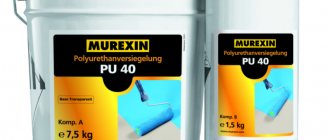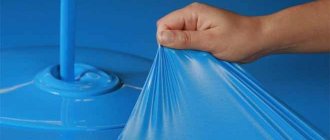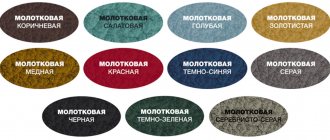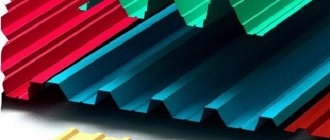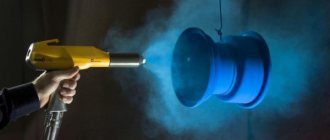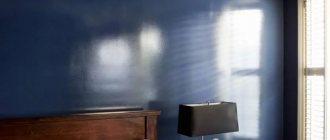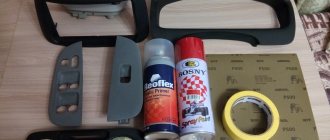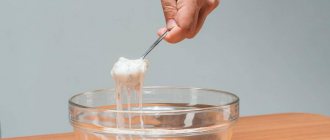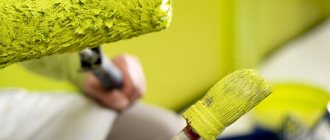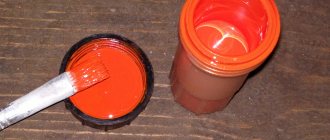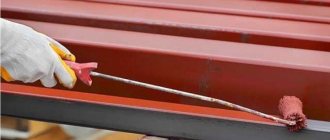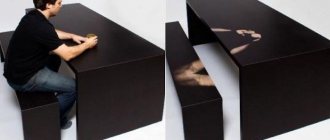How the operation is performed
- Stage 1 - the metal is first degreased, all dirt is removed from it, and treated with a special compound - phosphating, which increases adhesion and anti-corrosion properties;
- Stage 2 – a layer of paint is applied;
- Stage 3 – sintering of the coating and polymerization in a drying oven to form a film coating. For example, galvanized sheets with a polymer coating are used in facade and roofing work.
Powder painting technology
Powder paint melts when the temperature rises. At the same time, polymerization of the paint occurs. After this process, the powder coating layer cannot be melted.
The thickness of the powder coating coating for decorative purposes ranges from 20 to 80 microns. The thickness of the coating for functional purposes can range from a few microns to several millimeters, depending on the application. Such functional coatings are used for the production of polymer-coated corrugated sheets and metal tiles.
Types of polymer paints
Polymer paints come in all colors and shades of the rainbow. But besides color, there are other classifications. For example, depending on the material that forms a smooth polymer film when painting, powders can be: epoxy, polyamide, polyester, polyester-epoxy and made on the basis of epoxy resins. The texture of polymer paint can be matte, glossy or textured, and there are also shades of “moire” and “metallic”. Dyes are available for exterior use and for interior finishing of metal products. Depending on the method of hardening, polymers are also different: there are those that “set” on the surface of the product by simple heating, and there are paints that harden only under the influence of ultraviolet radiation. If the coating is formed as a result of a chemical reaction, it is a thermoactive paint, and if it is formed by melting and heating in a polymerization chamber, then it is a thermoplastic coating.
Polymer-based cement paints
Polymer cement paints are made from crushed polymer additives and light Portland cement mixed with pigmented particles and an aqueous composition with fillers diluted in it. To obtain polymer cement paints, polyvinyl acetate grinding is usually used. Polymer-based cement paints are used for painting large panel and block surfaces and external (plastered, brick, concrete) walls.
We have listed the main types and grades of paints, told what they consist of and what coatings they are intended for. But this is just a short story about colors. Volumes could be written about each of them, describing in detail each stage of creation and production. After all, these are all truly interesting processes, delving into which you can learn a lot of interesting and curious things. After all, knowing something unusual about some things, we begin to look at them differently, with interest, and then the world around us transforms and reveals its secrets.
Same with paints and varnishes. Having learned what a difficult path they went through before decorating our walls, or helping the things we need last longer, you will involuntarily begin to treat varnishes and paints, as well as the people who make them, with respect!
Table. Technical characteristics of polymer paints for concrete.
| Name | Epoxy | Polyurethane | Acrylic |
| Compound | Suspension of fillers and pigments on an epoxy compound | One-component material based on polyurethane polymers without organic solvents | Aqueous dispersion of fillers and pigments based on acrylic resins |
| Mass. share of non-volatile substances, % | 99 | 99 | 57-62 |
| Drying time at t +20 degrees up to 3 tbsp., h | 12 | 10 | 1 |
| Covering capacity, g/sq.m | 80 | — | — |
| Film strength upon impact, cm | 50 | 50 | — |
| Film bending strength, mm | 2 | 2 | — |
| Resistance to water, h | 72 | 72 | 24 |
| Resistance to fuels and lubricants, h | 72 | 72 | — |
| Grinding degree, µm | 80 | 80 | 60 |
Advantages of polymer paints
Powder dyes have a number of advantages, due to which they can be used to process external and internal products made of different types of metal. The advantages of polymers include: - they are not afraid of mechanical damage: if the metal product is damaged or deformed, the color will simply take a new shape, remaining on the surface; — water and moisture resistance: the polymer coating does not lose its qualities, even if the product is in or under water for a long time; - resistance to UV rays: while other types of paints from sunlight can fade, collapse and lose all their properties, the polymer coating will remain just as durable and bright, nothing will happen to it even on the sunniest day; — can withstand fire and high temperatures: since polymer painting is carried out under strong thermal influence, the coating is not afraid of high temperatures in the future; You can even use powder paint to paint your grill and heating boiler. - not destroyed by chemicals.
Scope of application of single component plastic dye
The constituent elements of a liquid polymer determine its area and purpose of use.
- Protects the base from the effects of atmospheric phenomena using plastic as a dye and enamel based on polyurethane, acrylic and alkyd. The colors introduced into the composition decorate the surface of different materials.
- The polymer composition protects from the UV rays of the sun, from stress, from high air humidity, and from temperature fluctuations. Such technical characteristics extend the service life of structures coated with polyurethane CMs.
As an example of the wear resistance of polymer dye, road markings on highways and at pedestrian crossings are considered. It does not lose its technological qualities for more than one year.
- In everyday life, such enamels are used to carry out repair work. Stairs on the street, facades, small architectural compositions, surfaces in the bathroom, balconies are covered.
Painting metal with plastic
Metal structures are protected from rust by enamel. It is made on the basis of alkyd resin, organic solvent, and polymer filler. It is applied to clean metal and to areas damaged by corrosion. Problem areas are first cleaned of peeling paint. A polymer film is formed. KM paints grilles on balcony windows, a metal canopy over the door, garage doors, and various piping systems.
Application in the bathroom
Elimination of the gap between the bathtub and the wall is carried out using plastic in liquid form. It renews the coating of the bathtub and the lower bowl of the shower stall. Restoration work is carried out in several ways using compounds:
- restoration of the top layer of the bowl with an acrylic mixture;
- Enamel of a special composition is applied to the surface. It is made from polymer materials.
The pouring technique is used to update the font with acrylic. KM is sprayed. After this, it spreads over the walls and bottom of the bowl. A durable film over its entire area is the result of the repair. The font is being transformed. The new coating strengthens the walls, increases resistance to mechanical stress, maintains the temperature of the liquid in the bowl for a long time, and reduces the likelihood of fungus appearing.
Thanks to liquid plastic, no money is wasted on purchasing new plumbing fixtures or repairing flooring and walls after the previous model is dismantled and a new one is installed. The repaired hot tub is ready for use after 36 hours. If the plumbing fixtures are used correctly, then after restoration with liquid plastic the coating will remain intact for 20 years.
Installation of PVC windows using CM
Until recently, sealing cracks when installing PVC windows was carried out with silicone sealant. Currently, liquid plastic or a white adhesive liquid is applied to the joint. When it dries, an elastic film is formed that connects the structural elements. The process resembles diffuse welding. The voids are eliminated when installing the PVC block. A solid surface without cracks or voids is the result of the work.
Plastic paint for PVC windows is known under the Cocmofen brand. It is easy to use for both professionals and DIYers at home. The material is color stable and does not shrink. The brand is available in 2 types. The joints between PVC window profiles are sealed using the first type of Cosmofen 345. The second Cosmofen Plus HV is used for gluing parts of the window structure and fittings.
Using Plastic Wood Paint
Liquid plastic paint for wood on a water-acrylic basis protects it from negative atmospheric phenomena, which will help avoid destruction of the wood inside. KM is used for interior and exterior work. The composition is water-based, therefore safe, does not have an unpleasant odor, and has a high drying speed.
Wooden house construction will last longer if the ends of the frame crowns are painted over with plastic CM. The wood is covered with a durable film that is elastic. It repels liquid and living organisms do not penetrate through it. The coating tolerates temperature fluctuations over a wide range, is resistant to damage and the use of detergents.
Any color can be selected by coating the wooden base with plastic dye. During the period of operation, the brightness of the shade is not lost. This is explained by the fact that special substances have been added to the composition that strengthen the polymer film and prevent the loss of color brightness. The composition is applied to the wood if it has been outdoors for 12 months (terrace flooring, staircase structures, fences).
How to choose paint
Polymer paint is chosen depending on the type of work, product and place of its further use. To decorate elements in the room, choose environmentally friendly dyes without a strong odor. To paint surfaces that will be used outside, polymer paints must be resistant to moisture, sun, and dust. It is recommended to choose quick-drying types of powder dyes. In addition, metal products require paints that protect against corrosion. You also need to decide which surface suits you - glossy or matte. Glossy is easier to clean and more practical. But matte can mask minor defects on the metal surface. You definitely need to look at the expiration date - the closer it is to the manufacturing date, the better.
Advantages
Regardless of the consistency of the paint, it has many advantages.
- High ability to penetrate even the smallest surface layer. Thanks to this, a protective layer is created on the item from water and corrosion.
- High resistance to sunlight. This quality allows you to protect the surface from fading and color abrasion.
- Resistance to mechanical and chemical damage, since polymers create a fairly thick layer on the object.
- Resistant to temperature changes.
- Affordable price.
- Economical. This paint can be applied in one layer, so one can is enough for a large area.
- Variety of types and wide range of colors. Due to this, this paint is widely used for decorating living spaces and antique objects.
- Versatility. Absolutely all types of surfaces—metal, wood, and glass—are subject to polymerization.
Thanks to its features, this paint is a worthy competitor in the paint market. And the variety of types and shades will allow the buyer to choose the desired option.
Scope of dyeing
Polymer dyes are used to process metal products for external and internal use. Polymer-based paints are used to cover pipelines, metal floors, elements of warehouses and ships. Paint is used not only as a decorative surface decoration, but also as a protective coating - for example, metal structures in swimming pools that are constantly in contact with water are painted. Polymer paint is used to paint cars, household appliances (bathtubs, boilers, boilers, refrigerators), and to process elements of bridges and viaducts, buildings and other metal structures.
Paints on polymer-emulsion (latex) bases
Emulsion paints based on polymer bases are colorful mixtures of two non-mixed liquid compositions, in which the molecules of one composition (grinding stage) are distributed in another liquid composition (grinding medium). To obtain a stable, non-separating emulsion, appropriate emulsifiers must be added during its production.
Emulsifiers are substances with surface activity that are adsorbed by liquids at the surface phase separation, reducing the percentage of surface tension. At the same time, a protective film appears around the pigments of the crushed paste, which does not allow the smallest particles of the material to enlarge and merge. Emulsifiers mainly include materials that have significant polarity, containing groups with active and inactive polarization. The polar group is represented by hydroxyl and carboxyl. For the production of emulsion paints, which are used in construction work, emulsions are most often:
- Lignosulfonate.
- Sodium salt of naphthenic acid (soap).
- Sodium abietates (soap rosins), etc.
A colorful emulsion composition of the water-polymer class, contains polymer additives crushed in an aqueous medium to a powder state. In addition to water and film-forming substances (rubber or artificial resin), it includes:
- Emulsifiers.
- Pigmented particles.
- Special additions to improve the quality of the material.
Emulsion-based paint is sold in a paste form, which is diluted during operation with a certain amount of water until the required thickness is achieved. Part of the water contained in the emulsion is absorbed by the surfaces treated with it, the rest of the water, exposed to atmospheric influences, simply evaporates. As a result, the emulsion components disintegrate, forming after some time a durable matte film that is resistant to light and water. Having a porous base, such a film does not allow gases to pass through. Because of this, emulsion paint is often used to coat wet plaster and concrete surfaces because excess moisture has the opportunity to evaporate through the porous coating layer.
Emulsion-based paint has minimal toxicity and is completely fireproof. They are used for painting work both indoors and outdoors.
Polyvinyl acetate based paints consist of a pigmented aqueous paste mixed with ground polyvinyl acetates with the addition of plasticized dibutyl phthalate. They are used for painting concrete, plastered, wooden surfaces, as well as for painting work with fiberboards and gypsum concrete parts.
Styrene butadiene paints are used mainly for painting interior spaces, and the use of such paints guarantees high quality work. Emulsion paint of the SEM grade is used in a similar way. Its composition includes glypthal varnish, water, emulsifiers, and special additives that improve the performance parameters of the paint.
Paint with an acrylate base is famous for its excellent weather resistance, which is why it is used for painting external walls and house facades, and for painting rooms with high humidity. They are available in a wide range of colors. Surfaces painted with waterproof emulsion paints can be washed with soap and water.
Surface preparation
Before applying a polymer coating to the surface of a metal product, it must be prepared. This is necessary so that the paint lays evenly, does not create a lump, and hardens quickly. When preparing a product for polymer painting, the master must clean the surface, remove all defects, remove grease and oil stains. If the product is old, then first you need to get rid of the remnants of previous painting and remove corrosion products. Cleaning and preparation of metal products is carried out by mechanical, thermal and chemical methods. Purpose of preparation: the finished surface should become as compatible as possible with the polymer coating, without losing its properties and qualities and not reducing the protective quality of the paint.
Galvanized sheets with polymer coating. What is the difference from painted ones?
When purchasing polymer-coated steel products, many do not understand how they differ from painted ones. After all, in fact, polymers are used in both cases, and they protect steel from external influences. This is all true, but in fact there is a significant difference between the treatment called polymer coating and painting.
Manufacturing technologies
The most important difference is in the technologies used. High-quality coated steel is produced exclusively in factory conditions, using industrial equipment. Our company purchases polymer-coated steel from well-known metallurgical plants, which carry out the entire production cycle, from metal rolling to packaging.
Later, in our production, the rolled steel is covered with a protective film, cut into sheets of the required size and delivered to the buyer.
Since we cooperate with leading metallurgical plants, we are confident in the quality of the material. The grade of steel used is one that has the best characteristics in terms of the production of roofing materials - strength, elasticity, thickness.
Before being coated with polymers, the steel is galvanized - a layer of zinc protects the metal from corrosion. At the same time, GOST standards clearly define the thickness of the zinc coating, and those manufacturers with whom we work strictly comply with the standards.
Another, no less important point is the application method and thickness, type of polymer coating. Even if the same raw materials are used, the technology of its application is of great importance. It is possible to achieve an even, sufficient layer thickness with the required characteristics only in modern production conditions, which are provided at large metallurgical plants such as NLMK and Severstal.
But, in addition to a quality product, there is also an economical option. It is manufactured mainly on Chinese equipment and does not always comply with GOST requirements. The cheapest steel is used, from which thin sheets are formed, the thickness of which is clearly lower than required, from the point of view of the production of metal tiles or corrugated sheets.
Such manufacturers also save on galvanizing - it is carried out, but the zinc layer is too thin (40-60 grams/m2). This steel can be used for interior work, but not for making roofing materials. Even during the process of forming metal tiles, the paint begins to crack. During the operation of the roof, the paint peels off due to violations of the technology for applying a polymer coating and preparing rolled steel before painting, which leads to rapid corrosion of the steel - a thin layer of zinc cannot fully protect it from precipitation, and a poor-quality coating can fade.
What is a polymer coating? This is a polymer painting process in which a polymer consisting of a mixture of pigments and other components is applied to steel. Polyester is applied in an even layer, after which it is heated. As a result, the polymer dries, forming a film on the metal.
Differences in polymer coatings
Now - about the difference between coating steel with a polymer coating in a large metallurgical enterprise compared to a small enterprise, as well as powder coating. The polymer coating, which is applied in a small enterprise, has a coating thickness of 18-20 microns, and not 25-30 microns as required by GOST. It is also impossible to prepare the galvanized coating before painting in compliance with all GOST requirements (washing, drying). The quality of the coating applied to an unprepared surface leaves much to be desired. The most common defects include sagging and variations in coating thickness. The advantages of this color include:
- efficiency
- dyeing speed
- medium corrosion resistance
- large selection of textures and colors
Flaws:
- low durability and average coating quality
In the conditions of large metallurgical plants NLMK and Severstal, the application of a polymer coating on galvanized steel fully complies with all GOST requirements, from the preparation of galvanized steel before painting, to the packaging of the finished product. At all stages of production, strict quality control of the polymer coating is carried out. At the same time, galvanized steel with a polymer coating is much cheaper than imported analogues and is not inferior in quality.
Advantages:
- high elasticity (steel is suitable for cold forming, without the risk of compromising the integrity of the polymer layer)
- sufficient thickness and uniform coloring
- resistance to various weather factors
- high corrosion resistance
- low cost
Flaws:
- less choice of colors and textures compared to the choice of colors in small businesses
Powder coating has also become widespread. This is a “dry” painting process in which a powder consisting of a mixture of polymer (polyester), pigments and other components is applied to the steel. The powder is applied automatically or manually to the finished product, after which it is heated. As a result, the polymers melt, forming a film on the metal. This coating has the following advantages:
- significant selection of textures and colors
- high resistance to external influences
- significant coating thickness
But there are also disadvantages:
- variation in coating thickness
- its low elasticity (steel is not suitable for further stamping without the risk of compromising the integrity of the polymer coating layer;
- high price
- shagreen covering
- low corrosion resistance
To summarize the comparison, we can conclude that each method of applying a polymer coating has its own advantages and disadvantages, which can be leveled out depending on the purpose and requirements for the finished product, as well as the budget allocated for construction.
